This is the Tower 41, a 35mm rangefinder camera built in Japan by Mamiya Optical Co., Ltd. for the Sears Roebuck and Company starting in 1961. The Tower 41 is similar to the earlier Tower 39, also built by Mamiya, but adding a combined coincident image rangefinder and a faster f/2.8 Kominar lens. Both cameras have a square “brick-like” body and distinct built-in flash reflector for use with AG-1 bulbs, and shutter priority automatic exposure courtesy of a coupled selenium meter. Unlike other collaborations between Mamiya and Sears, there was never any Mamiya branded version of this camera, suggesting it was designed specifically for the US market.
Film Type: 135 (35mm)
Lens: 43mm f/2.8 Mamiya-Tower Kominar coated 4-elements
Focus: 3 feet to Infinity
Viewfinder: Coincident Image Coupled Rangefinder w/ Projected Frame Lines and Aperture Scale
Shutter: Behind the Lens Leaf
Speeds: 1/40 – 1/250 seconds
Exposure Meter: Coupled Selenium Cell w/ Shutter Priority AE
Battery: (2x) 1.5v AA Alkaline Batteries (for flash only, camera is otherwise mechanical)
Flash Mount: Built-In Flash Reflector for AG-1 Flashbulbs, PC sync port for M X Sync
Weight: 714 grams
Manual: https://mikeeckman.com/media/Tower41Manual.pdf
How these ratings work |
The Tower 41 is a strangely designed brick-like camera made by Mamiya with a very good Kominar lens that produces excellent images. The camera has a good set of features and can be used both in shutter priority automatic exposure mode, or in manual mode. The viewfinder is bright and contrasty making it very easy to use, but there’s no getting around the poor ergonomics that somewhat ruin an otherwise very capable camera. Although I quite liked the results I got from it, this is a model that probably deserves to stay on a shelf. | ||||||
| Images | Handling | Features | Viewfinder | Feel & Beauty | History | Age | |
| 2 | 0 | 1 | 2 | 1 | 1 | 20% | |
| Bonus | none | ||||||
| Final Score | 8.4 | ||||||
History
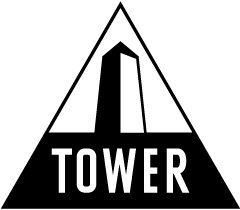
Today, when you want to buy a new camera, you load up a web browser, navigate to your favorite electronic website, click a few buttons, type in your credit card number, click a few more buttons, and then in a couple of days a nice man (or woman) brings a package to your door containing your new camera.
It wasn’t long ago though, that in order to buy something we had remove our sweatpants and put on real clothes, physically leave our houses, and actually go to a store filled with other people to buy a camera. In my life time, most camera purchases were done either at big box electronics stores like Best Buy or Circuit City, or an actual camera store.
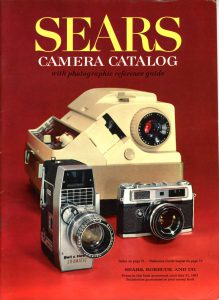
If you go back even farther, you’ll find an era where a large part of the population made their camera purchases through a catalog from a large department store. Companies like Montgomery Wards, K-Mart, and Sears had huge photo departments where you could buy anything you would need to make photos. These stores sold everything from the cheapest Kodak Brownie, all the way up to start of the art Leicas and Nikon SLRs.
In addition to cameras made by recognizable Japanese and German camera makers, these big chains would often sell their own house-branded cameras that they would get other companies to make for them. Montgomery Wards would often sell rebranded cameras under their own Wards name, such as the Wards am551 which was nothing more than a Konica Auto S2 with a new name, but Sears sold a huge lineup of cameras under their own Tower brand such as the Nicca made Tower 45.
Sears Tower cameras (it is interesting to me that there were Sears Tower cameras, but the actual Sears Tower in Chicago did not exist until 1973) existed as far back as 1952 when that year’s Sears Camera Catalog announced three different Tower branded models.
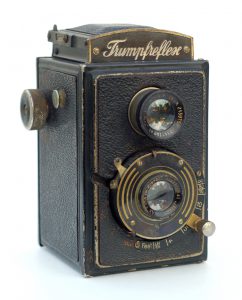
How Sears would choose which cameras to be rebranded as Tower models is not clear, but it seems that the manufacturers who produced them were smaller companies such as Bilora, Nicca, Ising, Asahi Optical, Iloca, Mamiya, and a few others. Most likely, Sears used their standing as a dominant force in US retail to entice these smaller companies as a way of getting their products into hands of American consumers, where they might have otherwise struggled to compete with bigger companies like Kodak, Zeiss, and Leitz.
A huge number of Sears Tower cameras were produced from the mid 1950s through the mid 1960s with designs including box cameras, medium format roll film cameras, rangefinders, SLRs, and even press cameras. Then around 1965, as suddenly as Tower cameras appeared, the name disappeared with future Sears cameras sold using the brand name “Sears”.
Of all the Sears Tower cameras, the one company that produced more than many other was the Japanese company, Mamiya. Although I’ve never been able to find a complete list of every single Tower camera ever made, in my research for this article, I was able to find a dozen different Tower models all made by Mamiya suggesting the two companies had some kind of long standing agreement.

Mamiya was one of the newer Japanese camera makers, originally founded in 1940 by inventor Mamiya Seiichi and investor Sugawara Tsunejirō as Mamiya Kōki Seisakusho (Mamiya Optical Works). The company’s first camera was the Mamiya Six, a folding camera that shot 6cm x 6cm negatives on 120 roll film. Mamiya saw immediate success upon the release of it’s camera, and was one of the few optical companies that continued to grow during World War II. By early 1944, the company had grown to 150 employees and had expanded to a second facility on the grounds of Tokyo University to build lenses.
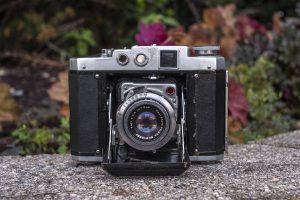
In October 1945, Mamiya was the first Japanese optical company to receive an order to resume production by the office of General Douglas MacArthur during the Allied occupation of Japan following World War II. A few months later in January 1946, Mamiya had resumed full scale production of the Mamiya Six at a new facility in Tokyo.
By 1950, with the support of the American Occupation Forces, Mamiya churned out model after model of new products in nearly every camera segment from medium format twin lens reflexes to 35mm rangefinders, and even a few subminiature “Bolta” cameras like the Mammy. Mamiya cameras were built for other companies like Nippon Kogaku, Canon, Riken, and even Argus.
In later years, Mamiya would see tremendous success with their professional level of Mamiya C-series TLRs and their medium format 6×7 and 6×4.5 SLRs, but for a period in the late 1950s to the early 1960s, a huge amount of Mamiya models were built for Sears.
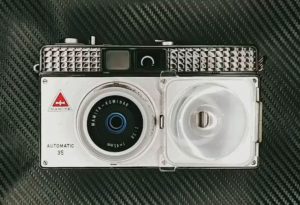
In 1961, Mamiya would release a new camera called the Mamiya Automatic 35 EEF. This strange looking camera combined both automatic exposure and an in body flash into a rectangular brick-like body. The Automatic 35 EEF was the first Japanese camera with an in body flash. The flash wasn’t electronic, and still used disposable AG-1 flash bulbs, but combined with two AA “pen light” batteries, offered flexible shooting that could capture properly exposed images in nearly every lighting condition.
As they did with a large number of their cameras, Mamiya produced a version of this camera for Sears, which they called the Tower 39. This camera first appeared in 1961 with a retail price of $44.27 which when adjusted for inflation, compares to about $385.
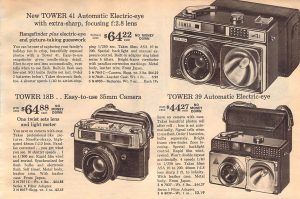
The very next year, an updated model which added a coupled rangefinder and a faster f/2.8 Kominar lens, called the Tower 41 would be sold in Sears catalogs. These additional features added nearly $20 to the price of the camera, matching it to the flash-less Tower 18B with it’s faster f/2 lens. Unlike with the Tower 39, there was no Mamiya equivalent to this camera. For reasons we’ll likely never know, the Tower 41 was a Sears exclusive.
While the feature set for the Tower 41 was compelling, the boxy body was not only strange looking, but uncomfortable to hold. Perhaps Mamiya took a cue from the Argus C-series, which had been in production since 1938 for it’s design, but whether it was due to poor ergonomics, or a price that didn’t match the tastes of Sears customers, the camera was only produced for about a year. I could not find any evidence of the camera being for sale past the 1962 Christmas season. As I write this, a quick eBay search for “Tower 41 camera” brings up only 3 for sale in the world, suggesting that not many were sold.
Apart from the ad above from the 1962 Sears Christmas Catalog, I found no other contemporary information about the Tower 41. No magazine ads, no reviews, no articles, nothing. It’s not often that I find so little about the camera, but here we are. This is certainly an interesting camera as despite their frequent rebadging of simple models, Mamiya was a capable camera and lens maker. Kominar lenses were produced by another Japanese company called Nitto Kogaku K.K. and are generally well regarded, so despite this camera’s strange appearance, should be capable of pretty good images.
Today, it is very likely many collectors have never heard of the Tower 41. A decent number of Nicca and Asahi produced models are desirable, but most of the lesser known ones are grouped together as forgettable cameras. The Tower 41 might be the rare example of a cool camera with compelling features and a good lens which deserves a better reputation.
My Thoughts
I have experience with Sears Tower cameras, I have experience with cameras made by Mamiya, and I have experience with cameras shaped like a brick, but until last year, I had no experience with a Sears Tower camera made by Mamiya shaped like a brick.
When my friend Adam showed me his recent pickup of a Tower 41, my first reaction was “geez, that’s ugly”, but after seeing the results he got from his, this visually obscene camera began to grow on me. This was a camera that was strangely designed, but had a capable feature set with an in body flash, a rangefinder, full manual control, and what looked to be a pretty decent lens. I thought hmm, maybe I should look for one for myself. As fate would have it, the Tower 41 Gods™ were shining down brightly as it only took a few seconds of searching before finding a pristine looking example for an incredibly low price, so now I had my own brick shaped Sears Tower branded Mamiya made camera.

When it arrived, I was impressed with the build quality. The body is almost entirely metal with minimal use of plastic. Compared to the also brick-like Argus C3, the Tower 41 is larger in every dimension and equally heavy. With it’s sharp corners and weighing in at 714 grams, this is not something you’d want to drop on your bare foot!
A subtle, but nice touch to the camera’s body covering is that it consists of a bunch of tiny letter “Ms” in a repeating pattern. This “M” skin was also used by Mamiya on their professional C-series TLRs, suggesting a bit of class in this model.
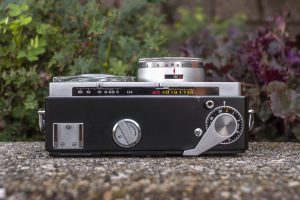
The top plate is a bit unorthodox, but has most of the features you’d expect. Starting on the left is the accessory shoe, which I can’t really think of a reason anyone would use this since it already has a built-in flash and a rangefinder, which are the two things you’d normally connect to an accessory shoe. The camera does have an external flash sync port, so I guess rather than using the built-in flash, you could connect a second, larger flashbulb unit.
In the middle is a normal looking rewind knob with flip out handle. The location of this knob towards the middle is a little odd, until you remember that the left third of the camera is for the flash, not the film compartment.
On the far right is the film advance lever with the manual resetting exposure counter beneath it. The shutter release is near the upper left corner of the counter, and is threaded for a cable release, which is odd as this camera lacks a Bulb mode or any speeds slower than 1/40.
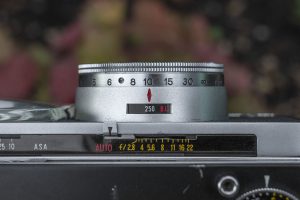
On the black trim piece in front of the top plate are two sliders, one for adjusting the film speed, and the second for putting the camera in auto exposure mode, or manually selecting an f/stop.
A rectangular window above the shutter shows the shutter speed which is selected by a lever beneath the lens. In the image to the right, I have the camera set to 1/250 and in Auto mode. There are only four possible choices for shutter speeds, 250, B.L. which the manual says stands for “Back Light” and is likely around 1/125, 60, and finally a the word Flash, which the Sears ad in the history section above says is 1/40.
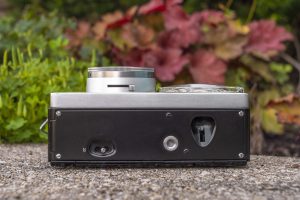
From the bottom, you can see the slider beneath the lens for changing shutter speeds, and on the camera’s bottom plate, a 1/4″ tripod socket, rewind release slider, and a flash bulb eject lever, used to replace the bulb after each use.
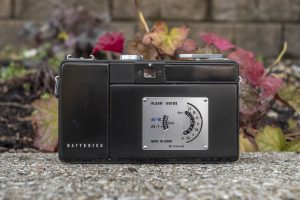
The back of the camera has a neat flash guide that allows you to calculate the maximum flash distance for a given f/stop depending on what speed film and bulb you use. It’s not really useful for anything but the in body flash, but is still cool and helps to break up what would have been a large swath of black metal.
Above the door is the eyepiece for the viewfinder with a frame around it that functions as the door release. By simply pressing up on this frame and the film door opens. This is one of my least favorite attributes of the camera as I found that it doesn’t take much more than a gentle upward tug on this frame and the door pops open.
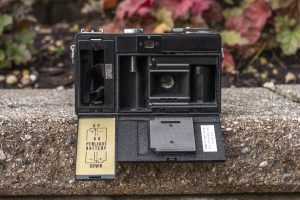
On the left is a separate compartment for two AA batteries needed to power the flash. The use of AA “pen light batteries” as they were often called then, was a pretty big advancement as many flashes of the era still required special 22.5 volt “flash” batteries and sometimes auxiliary capacitors to work.
The film compartment is rather ordinary, with left to right film transport onto a single slotted fixed take up spool. Threading film onto the spool is very easy as the opening in the spool is quite large with a single tooth on the edge to grip one of the sprocket holes on the film. With the leader inserted, winding the film advance lever twice is enough to securely attach the film. The pressure plate is large and has small divots on it which help reduce resistance as film transports through the camera.

Notice the silver sticker on the inside of the door which reminds you that this camera is only sold through Sears stores. This is the only spot on the entire camera with the Sears name.
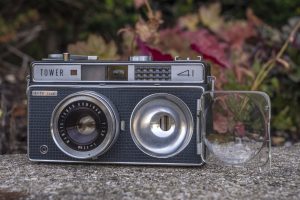
The most striking feature of the Tower 41 is the built in flash reflector on the front face of the camera. Mirroring the shape and size of the lens, at a quick glance, gives the camera a sideways TLR appearance.
The concept of in body flash reflectors was a short lived fad that a few manufacturers played with in which compact flash bulbs, in this case the AG-1 could be inserted into the holder behind a hinged clear plastic window. The flash is powered by two AA batteries inserted into the back of the camera. These types of in body flash reflectors quickly gave away to flashcube ports and eventually pop-up electronic flashes. If an AG-1 flashbulb was not powerful enough, the camera still had a standard PC flash port on the front face for external flash guns as well.
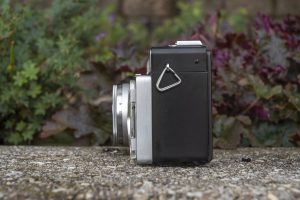
Other than a pair of protruding strap lugs, there is nothing to see on the sides of the camera. A look at the camera’s profile shows a rather chunky body with a fairly narrow shutter.
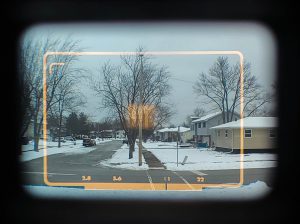
The viewfinder, although not as large as some other cameras of the day is still big enough to be useful. Wearing prescription glasses, I had no trouble seeing all four sides of the projected frame lines or the meter readout on the bottom. Projected yellow frame lines with parallax correction marks, a rectangular rangefinder patch, and an aperture meter readout contrast nicely with the blue tint of the main viewfinder.
The metering system on the Tower 41 is interesting as it never really turns off. With the aperture slider set to Auto, you have a full range of f/stops from 2.8 to 22 for the camera to select. The needle within the viewfinder will point to whatever would allow for a properly exposed image with the selected shutter and film speeds. If however, you move the slider away from Auto to any manual setting, you’re not actually turning off the auto exposure system, rather, you’re setting a limit to no wider than whatever you’ve selected. So for example, lets say you set the slider to f/8 but the meter determines that f/16 is the correct aperture, the camera will still use f/16. Setting the slider to f/8 merely acts as a limiter that prevents the auto exposure system from using anything faster than f/8.
Overall the Tower 41 is a bit of an ergonomic disaster, but otherwise has a compelling feature set with features that would have made it competitive in the market upon it’s release. Mamiya was known for making good cameras and lenses at the time, so images from the Tower 41 should be pretty good. The camera was only produced for a very short time, so it’s likely that the strange aesthetics failed to capture the buying dollars of those looking for a camera at the time, or was it something else?
My Results
When the camera arrived, the shutter would not reliably fire, so I flushed it a couple of times until I could get it working. The metering system seemed to work, but I still had my doubts about the functionality of the camera, so I loaded in some surplus Arista.Edu 100 bulk film. I quickly shot about a dozen or so shots around my house and developed it.
I was elated to see a roll of properly exposed and very sharp images. Most of the images had light leaks around the edges though, suggesting that the camera needed some attention to the light seals. I took care of that, and loaded in a second roll of Kodak Vision3 50D color film.
I shoot lots of test rolls in cameras before confirming their functionality and don’t often share the results from those images, but I included them here because looking past the light leaks, they turned out pretty good and show how sharp the Kominar f/2.8 lens can be using black and white film.
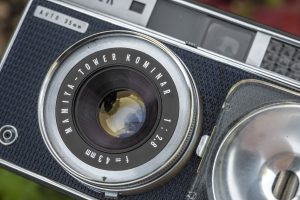
Once I sorted out the light leaks and shot the second roll, the color film looks as good as any f/2.8 rangefinder I’ve ever shot. I am not sure of the make up of the Kominar’s lens formula, but my guess is it is a Tessar equivalent, like pretty much every other 4-element f/2.8 lens made in the 20th century.
Sharpness is excellent in the center and only shows a slight softening in the corners. A very small amount of vignetting can be seen in outdoor pics, but nothing that even remotely comes close to being bothersome. Like all Tessar style lenses, the rendering of this lens produces a pleasant vintage look that people often like about classic film cameras like this. Had I not told you what camera made these pictures, you would never know this wasn’t made by a huge number of more popular German or Japanese models from the same era.
The viewfinder is bright and easy to use. Although the Tower 41 upgrades the earlier Tower 39 with a rangefinder, the semi-wide 43mm focal length of the Kominar lens affords a good amount of depth of field, which means that even without a working rangefinder, guessing focus would be pretty easy. The camera lacks a depth of field scale, but using a simple online calculator, setting the lens to f/11 and focusing to a distance of 15 feet away, everything from about 8 to 68 feet will be in focus, making quick snapshots very easy to do. If you like the results from this camera, but can only find the rangefinder-less Tower 39, don’t let that dissuade you as it will likely be just as easy to use.

I don’t have any AG-1 bulbs to use, so I never bothered to try out the camera’s flash, but I suspect it works similarly to any in body or popup flash found on a huge number of other cameras.
By far, the camera’s most distinct attribute is also my least favorite part of the camera. The squared body has sharp corners making it really difficult to slip and out of pockets. Compared to an Argus C3, which is affectionately known for it’s brick-like shape, the Tower 41 is bigger in every dimension, including weight, compared to the C3. Thankfully, the Tower 41 does have strap lugs which I would highly recommend taking advantage of if you planned on carrying this camera on an extended shooting session.
Ergonomics aside, the Tower 41 is a pretty fun camera. It checks off most of the right boxes when it comes to finding interesting and quirky cameras that can still deliver great results. The viewfinder is as good as most anything from the era, the lens is great, and with shutter priority auto exposure and an in-body flash, is capable of quality images in nearly any lighting situation. In the event you find one with a dead meter or inoperable electronics, the shutter is completely mechanical and the camera still offers full manual operation which is a definite plus.
Despite my fondness for this camera, I doubt it’s one I’ll use often because the poor ergonomics and comparable feature set to so many other cameras. It’s just not a camera I’ll reach for often, but don’t let that dissuade you from checking one out if you have the chance. I am very happy to have this camera in my collection, and I think you would too.
Related Posts You Might Enjoy
External Links

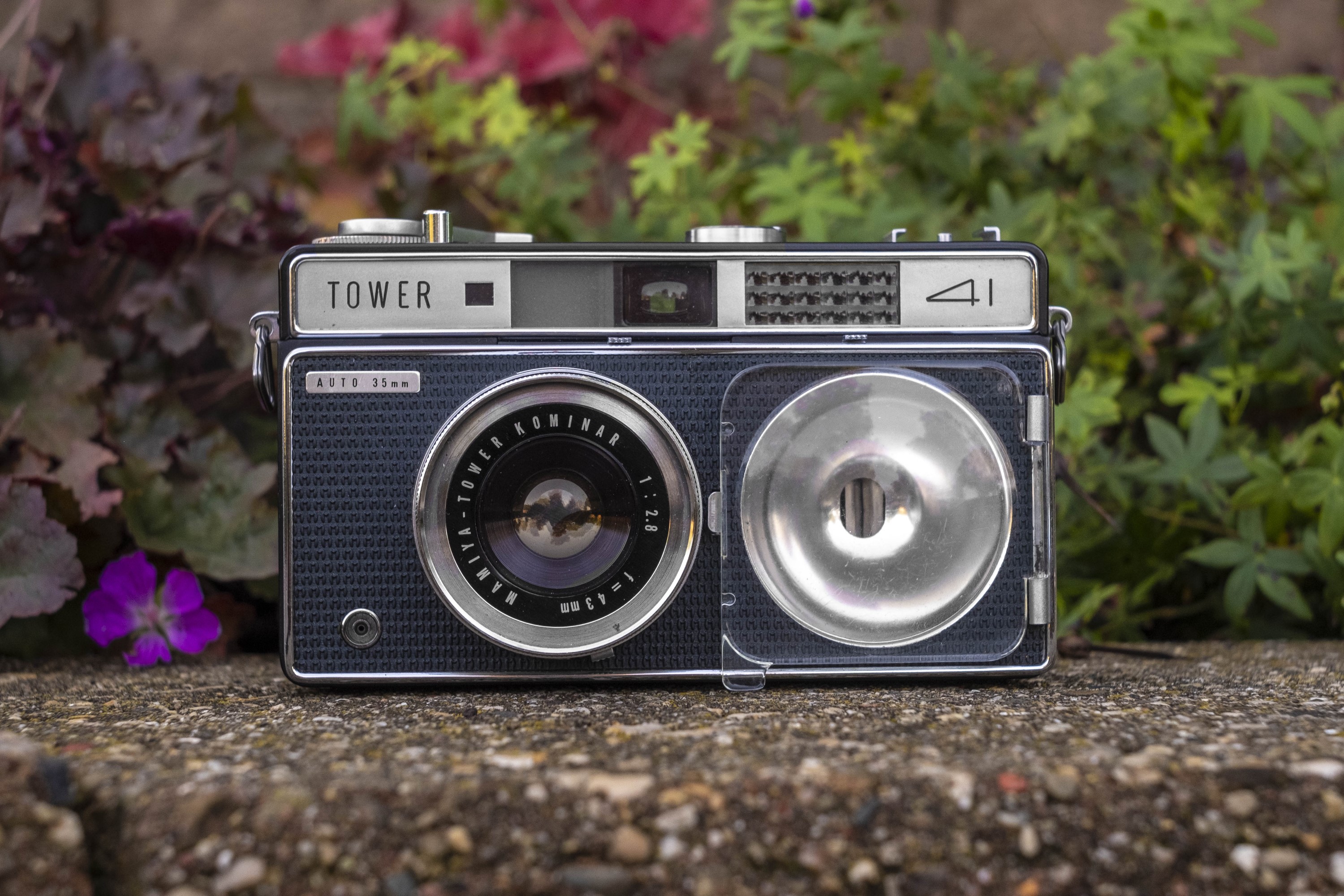

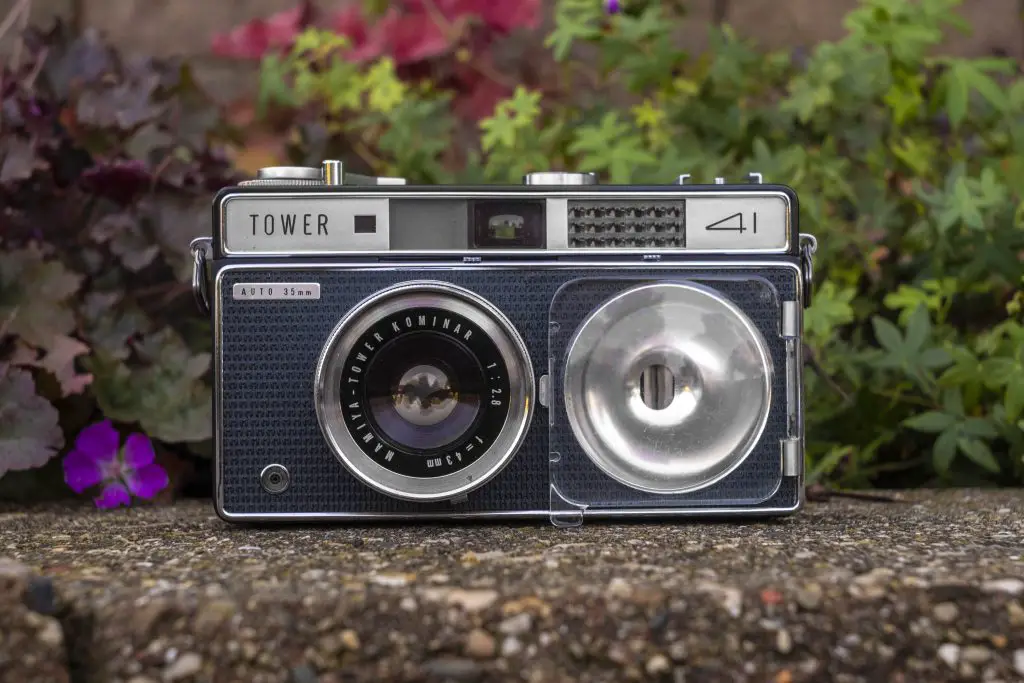


















Nice post. You got some cool images out of it.
Thanks Chris! It wasn’t hard as the Kominar lens is quite good! I wish they made a flash-less version of this camera with better ergonomics. It would be an excellent shooter!
The Tower name may be a nod to VEB Pentacon, who used a tower logo to identify many of their cameras. That logo was widely recognized by photographers in the 1960s.
Ya know, I never considered that! It very well could be a nod to that, especially considering at one time, Sears sold the Trumpfreflex here which was a Richter camera, which eventually became part of Pentacon too. You could be onto something! 🙂
Another nice feature of the camera is a PC socket, that will work with a modern electronic flash, in case you don’t want to track down some AG1 bulbs. I prefer to have a couple bulbs in my bag when I shoot this. It’s less bulky that carrying around a separate flash, so I can do an occasional flash photo.
Sears may have adopted the Tower branding as an acknowledgement of VEB Pentacon’s tower logo. That image was well-known to photographers of the era, and would have suggested Zeiss-like quality in the Sears products, at no extra charge.
Great post, Mike! I haven’t had luck finding documentation on this yet, but I believe that the “Tower” name was associated with the brick-n-mortar Sears Roebuck department stores thanks to their architecture. They all seem to have incorporated a tower-like element to the design, perhaps hearkening back to the distinctive architecture of the Sears headquarters building.
https://en.wikipedia.org/wiki/Sears,_Roebuck_and_Company_Complex#/media/File:Photographic_copy_of_photograph_(circa_1950,_original_print_in_Archives,_Public_Affairs_Department,_Sears_Merchandise_Group,_Hoffman_Estates,_Illinois),_Photographer_unknown._HABS_ILL,16-CHIG,110-14.tif
This is one of my favorite cameras, I didn’t find the ergonomics an issue at all, Other than opening the film door, which puzzled me for a while. I’ve even used it with flash bulbs at Christmas. It’s a Fun camera.
Hey there Mike — hope that you and the family are having a great and healthy Christmas! Just got one of these with case — rather dusty, but from what I can see, most likely never used. Everything moves/adjusts OK except the shutter never seems to open no matter what I set the camera for. Set to 1/60, ASA 200 and Auto I do see the aperture needle move all across the viewfinder scale when shining a flashlight across the selenium meter. If I switch to 1/250 — the needle stays at the very are end (past 2.8) no matter what. I wind the handle, have the back open and turn the sprocket wheel one frame until it locks, push the shutter release and don’t feel a “click” through the shutter button and no movement of the shutter. How did you get “in” to clean/lubricate the shutter on yours? Thanks!!!
(let me try this again — I got a “mikeeckman.com refused to connect” error on my last attempt) Merry Christmas Mike and family! Just got one of these with the case. Very dusty, but looks to be unused. Everything adjusts/opens, but not the shutter. The meter needle in the VF swings the whole way when set to 1/60, ASA 200 and Auto and moving a flashlight across the meter window. At 1/250 — the needle stays all the way at the left, past 2.8. I wind the winder, turn the internal sprocket gear one frame until it clicks/locks, push the shutter release and — nothing. Cannot see the shutter open at all from the back or front. How did you get at the shutter to clean/lubricate it? Thanks!!!
The problem with cameras that look (or actually are) unused is that they have never been broken in and their lubes are usually dried to a cement. On mine, a few drops of naphtha was all that was needed to free up the shutter when I first got it, but if yours is totally seized, you might need to unscrew the entire front element and get into the shutter. Be careful with that camera though as if you take the lens apart, you need to be mindful to mark the orientation of the elements exactly so that you don’t throw off the focus when you put it back together. Normally, if you throw off focus, it’s easy enough to collimate it to get it correct, but you need a shutter with a B or T mode, which the Tower 41 lacks. With no way to hold the shutter open, it’s impossible to collimate it using the usual method.
You mentioned “When the camera arrived, the shutter would not reliably fire, so I flushed it a couple of times until I could get it working.” How exactly did you do this? I happened across one of these in an antique store in what seemed to be mint condition, the shutter didn’t fire so I put it on the shelf…found another one on Bay cheap enough and took a chance…well same luck, shutter doesn’t do anything. camera seems to be working nicely otherwise. How do I “flush” the shutter? I’d like to use the nicer of the two I got 🙂 Thx in advance…see what I did there.
I unscrewed the front lens element and used gratuitous amounts of naphtha oil and doused the shutter until it started firing. I then soaked up any excess fluid with Q-tips and let it all air dry for 24 hours. The challenge though is that by unscrewing the front element, you lose infinity focus, so when putting the lens back on, you have to be very careful to get it on the exact right way. Normally when I do this, you can collimate the lens with a piece of ground glass in the film plane (I cover how to do this in my Breathing New Life into Old Cameras article), however you need a shutter with a Bulb or Timed mode which can leave the shutter open to do this, which the Tower 41 lacks. So basically, I just guessed at what it would be, and through trial and error, got it collimated. It’s certainly not for the novice, but if you’re patient and careful enough, you can do it!